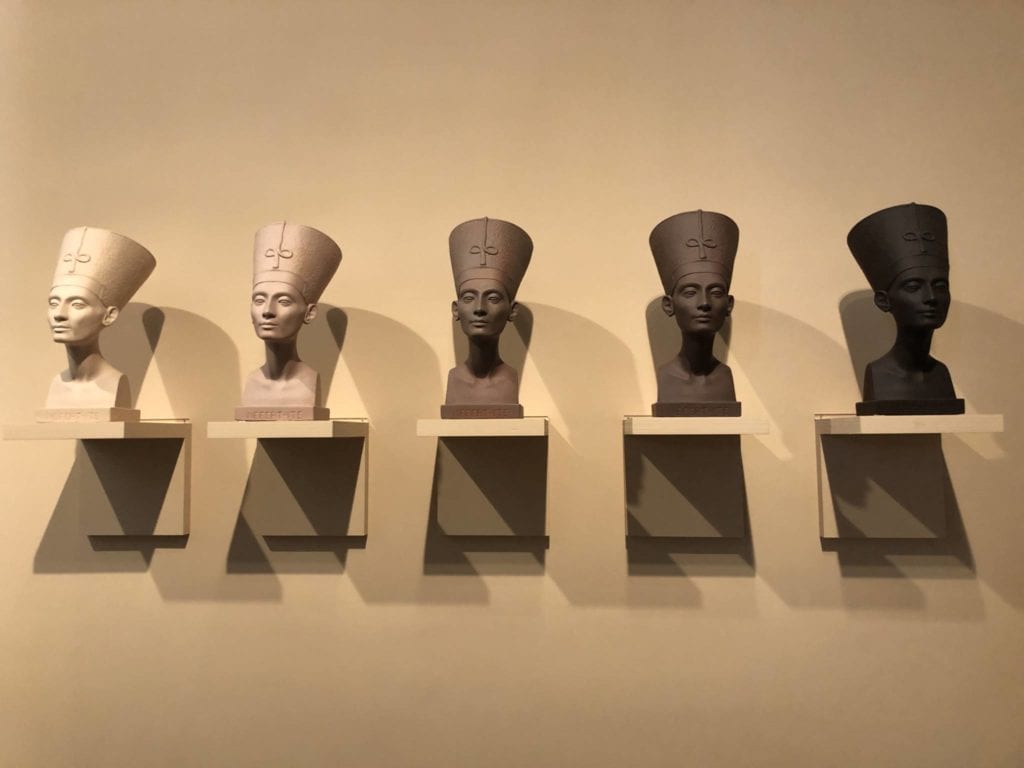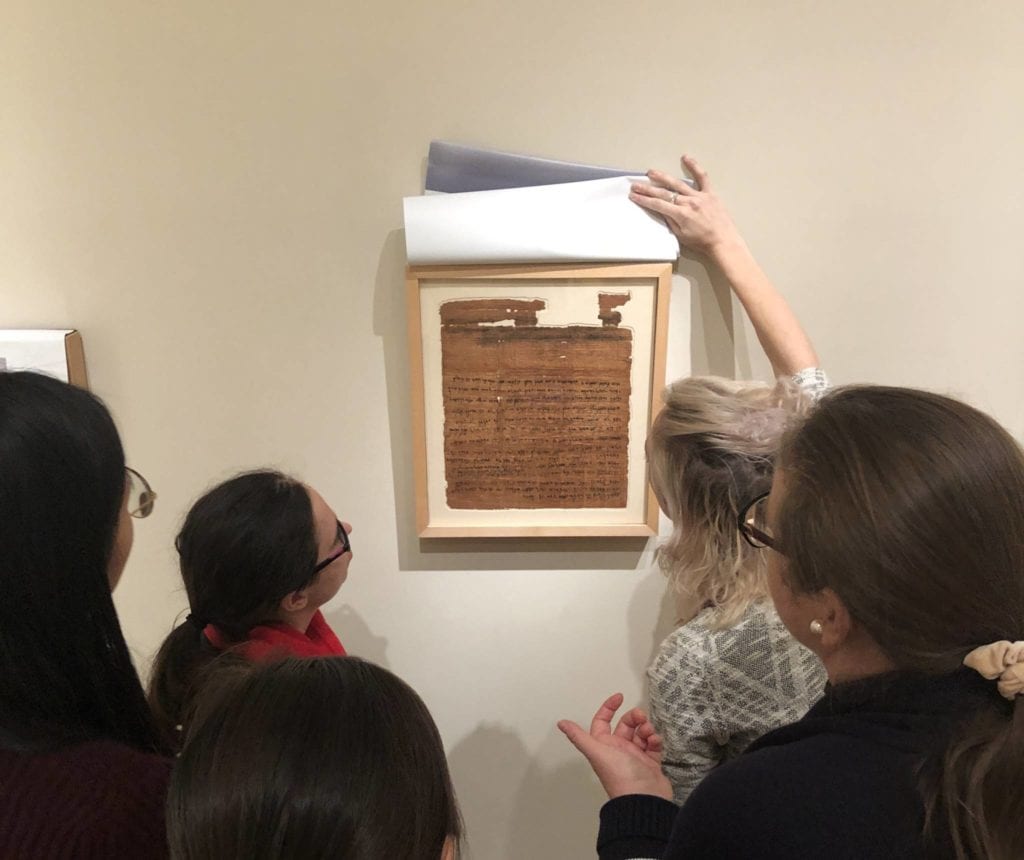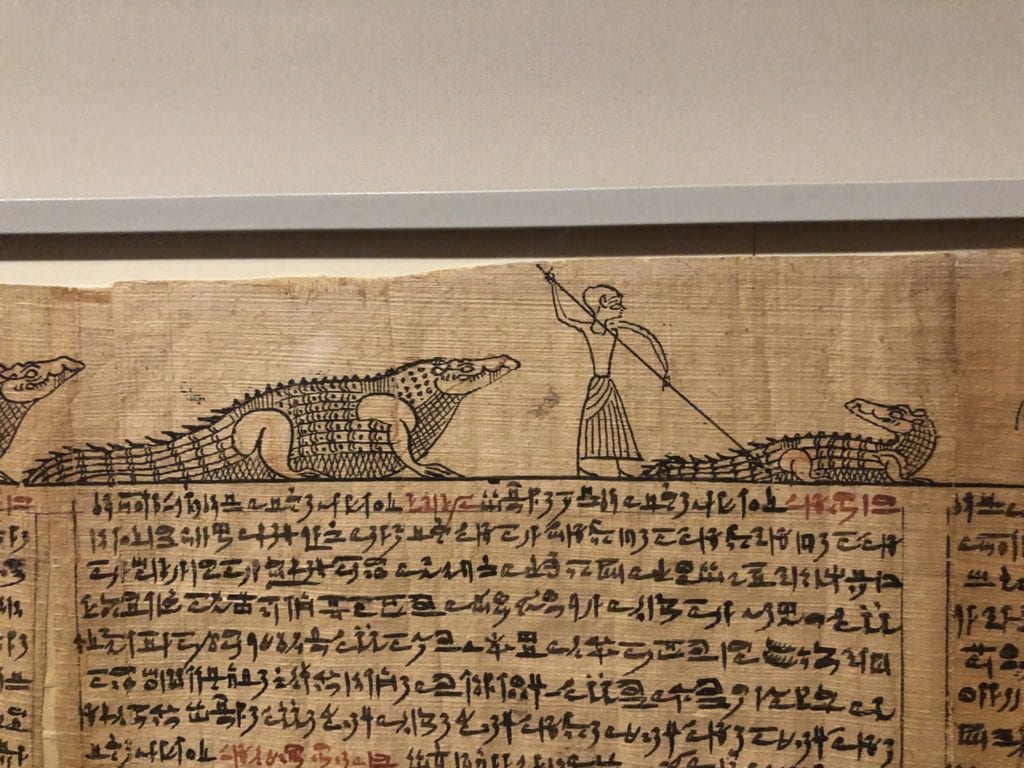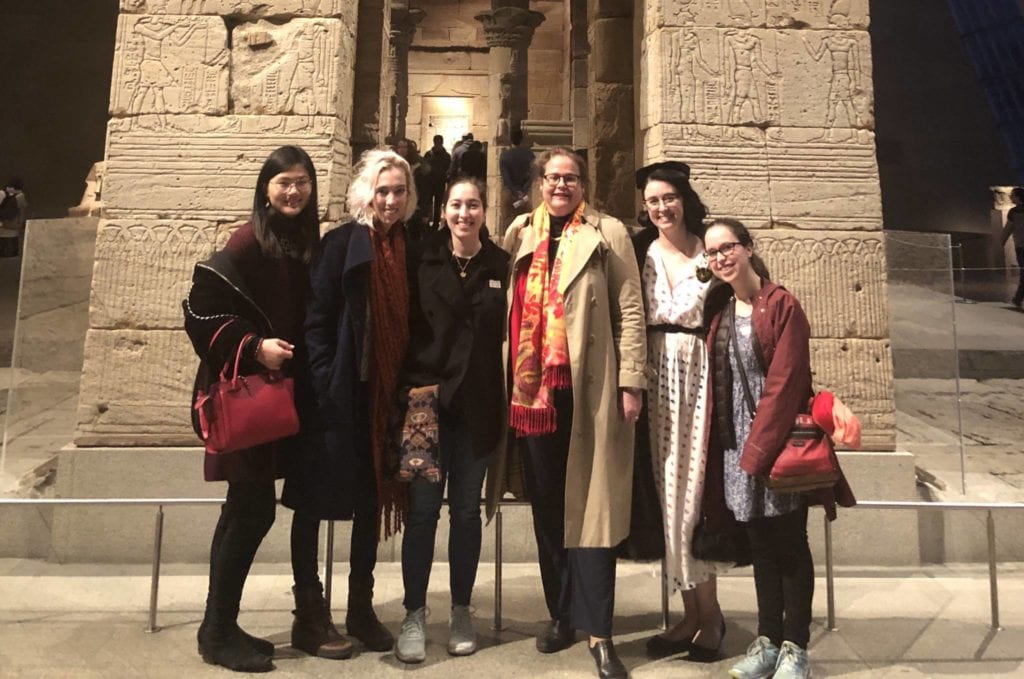This fall, as part of the Humanities Council’s Global Initiative in Comparative Antiquity, Verena Lepper, the 2019-20 Stewart Fellow in the Humanities Council and Department of Religion, taught a seminar on “Ancient Egyptian Manuscripts: Writing, Materiality, Technology” (REL 404/CLA 404/HUM 404). Students visited the University Library’s Special Collections for a close look at hieroglyphic and hieratic scripts, and the newly acquired Book of the Dead at the Princeton University Art Museum. The seminar also explored a selection of Coptic, Demotic, and Greek papyri and ostraca, with guest lectures by AnneMarie Luijendijk (Religion), Marina Rustow (Near Eastern Studies), Martin Kern (East Asian Studies), and Thomas Hare (Comparative Literature), and Bryan Just (Princeton University Art Museum).
In November, Lepper led a field trip on which students visited collections in the Brooklyn Museum of Art, The Morgan Library and Museum, and The Metropolitan Museum of Art. (In the short article below, Rachel Richman, a 2nd year PhD student in the Department of Near Eastern Studies, writes about the trip.)
“The final project is to create an exhibit about ancient manuscripts held at Princeton. All this will give the students great insight into one of the oldest written cultures of humankind.” Lepper said.
In January 2020, after the conclusion of the course, students can apply for research funds to view first hand the Ancient Egyptian artifacts at the Neues Museum in Berlin. They will visit the Egyptian Papyrus Collection, which houses 60,000 papyri and manuscripts, and the museum labs and the depositories where they will see behind the scenes conservation and research.
Martin Kern, Director of the Comparative Antiquity Initiative added, “This class has been a unique contribution to the study of antiquity at Princeton—a deep and close look at Egyptian manuscripts enriched by a range of comparative perspectives. In just one short semester, this group of enthusiastic students, led by their phenomenal instructor, studied some of the most fascinating materials in the early history of human writing in a global context, and explored the preservation techniques, display formats, and scientific analyses of Egyptian papyri; and now they are going to bring Princeton’s own manuscript treasures to light. This is exactly the kind of transformative learning experience for which we started the Comparative Antiquity initiative.” Kern is the Joanna and Greg ’84 P13 P18 Zeluck Professor in Asian Studies and Chair of the Department of East Asian Studies.
Verena Lepper is Curator of Egyptian and Oriental Papyri and Manuscripts at the Ägyptisches Museum und Papyrussammlung, Staatliche Museen zu Berlin, and honorary Professor at the Humboldt University Berlin. She is the author and editor of several books on Egyptology and is chief editor of two monograph series: Ägyptische und Orientalische Papyri und Handschriften des Ägyptischen Museums und Papyrussammlung Berlin (DeGruyther) and Studies on Elephantine (Brill).
A Student’s Perspective: Saturday at the Museums
By Rachel Richman
With the support of the Humanities Council, our Ancient Egyptian Manuscripts class was able to visit three museums in New York over the weekend. By seeing the various curating styles, we were able to come up with a strong plan for our own exhibition (hopefully coming to Princeton in 2021/22).
First, we visited the Egyptian collection at the Brooklyn Museum. The object labels were informative and thought provoking – the education department has a larger hand in shaping the Brooklyn Museum labels than most other institutions. One of the thoughtful framing pieces was a critique of how previous generations of Egyptologists had “whitened” the field, and this was complemented by a modern installation of busts of Nefertiti in a variety of skin tones.

Because our class focuses on manuscripts, it was particularly interesting to see how the Brooklyn Museum displayed texts. The papyri are kept under a fabric screen, so they are exposed to light only when guests actively engage with them.

The Book of the Dead was laid out beautifully in a narrow, low-light space and rolled out in full (over 24’ long!) in a glass case. Mounted on the wall behind it were excerpts in both hieroglyphs and its English translation so you could find the matching section in the real papyrus below.
After a debrief, we went to the Morgan Library. While none of the Egyptian material was on display, the Verdi exhibition gave us ideas about how to possibly incorporate sound and video components into our future exhibit plan.
Our last formal stop was at the Met. With such a vast collection on display, it was wonderful to be guided through by Dr. Lepper and her knowledge of the holdings. We saw a wall-mounted display of another long Book of the Dead scroll with delightful illustrations.

Early Ptolemaic Period ca. 332–200 B.C., probably from Middle Egypt, Meir. Papyrus and ink. Gift of Edward S. Harkness 1935. Metropolitan Museum of Art 35.9.20a–w. Photo: Emily Smith-Sangster
While the Met has some of the most stunning texts, statues, and mummies on display, the lack of interpretative labels was frustrating. By emphasizing the artistic value, much of the cultural and historical meaning felt lost.
We closed with a lovely dinner, sharing our favorite museum exhibitions of all time and discussing female empowerment in academia.

To read more about the Ancient Egyptian Manuscripts seminar and Princeton University Library collections, visit: https://blogs.princeton.edu/manuscripts/2019/10/28/egyptology-seminar/
















